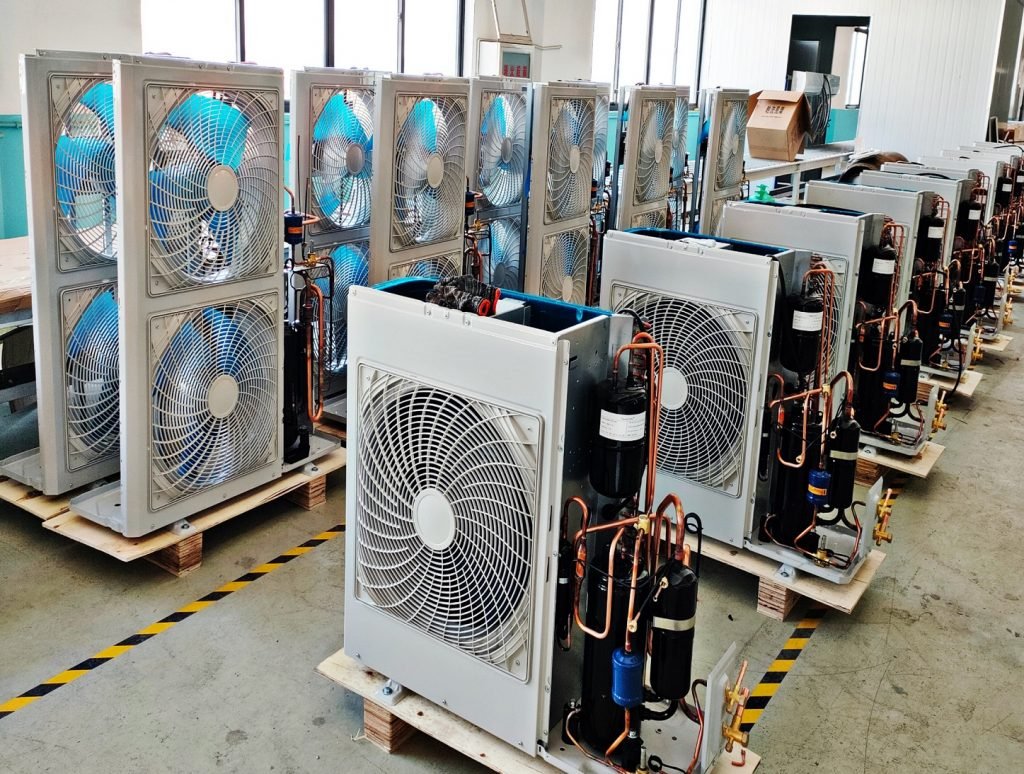Kühlsystem ist ein komplexes Zyklussystem, das aus Schlüsselkomponenten besteht, wie z. B. Kompressor, Kondensator, Expansionsventil, Und Verdampfer. Diese Komponenten arbeiten zusammen, um die Kühlung durch den Kühlkörper zu erzielen.
Jedoch, Wenn Luft in dieses geschlossene System eintritt, Es kann Serienprobleme verursachen, die sich auf den normalen Betrieb auswirken. Deshalb, Es ist entscheidend, die Ursachen zu verstehen, Verteilung, Gefahren, und Entfernungsmethoden zum Eindringen von Luft in Kühlsystemen.
Ursachen für Luft im Kühlsystem
Obwohl Kühlsysteme sind versiegelte Zyklen, in denen Luft nicht eintreten sollte, Luft kann aus verschiedenen Gründen immer noch infiltrieren.
Im Folgenden finden Sie eine detaillierte Analyse dieser Ursachen:
1.Unvollständige Staubsaugen während der Installation oder Wartung
–Das Staubsaugen ist entscheidend für die Entfernung von Luft und Feuchtigkeit während der Installation oder Wartung. Schlechte Vakuumpumpenleistung oder unzureichende Staubsaugerzeit kann die Luft im System lassen.
–Unerfahrene Betreiber oder Geräteprobleme können auch zu unvollständigem Staubsaugen führen.
2. Luft eingeführt während des Kältemittelsadditions
–Unsachgemäße Verfahren, wie unversiegelte Kältemittelbehälter oder falsch verbundene Schläuche, kann es zulassen, dass Luft das System während des Systems betreten kann Kältemittel Zusatz.
–Offene Füllmethoden erhöhen die Wahrscheinlichkeit, dass die Luft eindringt.
3. Systemleckage
–Leckagepunkte im System können Luft hineinlassen, Besonders wenn beide hoch & Niederdruckseiten haben Lecks. Druckunterschiede erleichtern das Eindringen von Luft.
–Leckage tritt häufig bei Rohrverbindungen auf, Ventildichtungen, oder Kompressordichtungen.
4. Verwenden Sie minderwertige Kältemittel oder unversiegelte Behälter
–Minderwertige Kältemittel können Verunreinigungen oder Feuchtigkeit enthalten, Luft in das System einführen.
–Schlecht versiegelte Behälter lassen die Luft mit dem Mischen Kältemittel und anschließend das System eingeben.
5. Mangel an Luftentfernung während des langfristigen Betriebs
–Im Laufe der Zeit, Luft kann das System langsam infiltrieren, insbesondere bei erheblichen Druckschwankungen.
–Fahrlässigkeit oder fehl funktionierende Luftentfernungsgeräte können zu Luftansammlungen führen.
6. Atmosphärische Luftdurchdringung
Wenn der Betriebsdruck des Systems niedriger ist als atmosphärischer Druck, Luft kann durch Lücken in Ventilen in das System eindringen, Kompressoren, oder nicht geschweißte Verbindungen.
7. Zersetzung von Schmieröl
Manche Schmieröle, wie Mineralöle, kann unter komplexen Arbeitsbedingungen zersetzen, Kohlenwasserstoffe freigeben, die sich mit dem Kältemittel mischen.
Verteilung der Luft im Kühlsystem
1. Natürliche Akkumulationsorte
Luft ist leichter als Kältemittel und neigt dazu, sich an Höhepunkten des Systems zu sammeln, wie zum Beispiel:
Kondensator: Oft in einer hohen Position im System installiert, Machen Sie es zu einem gemeinsamen Luftakkumulationspunkt.
Empfänger: Ein weiterer Höhepunkt, an dem Luft leicht sammelt.
Akkumulator: Bestimmte Systeme sehen die Luft hier ansammeln.
Hohe Pfeifenabschnitte: Jeder erhöhte Rohrabschnitt kann zu einem Ort für die Luftakkumulation werden.
2. Luftbewegung im System
Luft kann sich im Kältemittel auflösen und sich während des Betriebs durch das System bewegen, verschiedene Komponenten beeinflussen.
3. Auswirkung des Systemdesigns auf die Luftverteilung
—Komplexe Rohrleitungen: Erhöhen Sie potenzielle Bereiche für die Luftakkumulation.
—Höhenunterschiede: Große Höhenschwankungen im System können an höheren Punkten zu konzentrierter Luft führen.
Luftgefahren im Kühlsystem
1. Erhöhen Sie den Energieverbrauch
Luft besteht hauptsächlich aus Stickstoff und Sauerstoff, die nicht kondensbaren Gase sind. Luftakkumulation in der Hochdruckseite erhöht den Systemdruck, erzwingen Sie die Kompressor härter arbeiten, Erhöhen Sie den Energieverbrauch und Verschleiß, und verkürzen Sie die Lebensdauer des Kompressors.
2. Chemische Reaktionen induzieren
Feuchtigkeit in der Luft kann mit reagieren Kältemittel, vor allem in Mineralölsystemen, Erzeugung saurer Substanzen, die interne Metallkomponenten korrodieren, was zu Lecks und Beschädigungen führt.
3. Reduzieren Sie die Kühlungseffizienz
Luft im Kondensator oder Verdampfer kann verursachen „Luftschlösser,“ Behinderung des Kältemittelsflusss und Wärmeaustauschs, Verringern Sie die Effizienz des Gesamtsystems.
4. Eisblock bilden
Feuchtigkeit in der Luft kann in Drosselern einfrieren (z.B., Expansionsventile), Blockaden verursachen, die stören Kältemittel fließen und die Ausrüstung beschädigen können.
5. Leistung der Expansionsventil beeinträchtigen
Die Präsenz der Luft kann Druckmesswerte am Expansionsventil verzerren, führen zu unsachgemäßen Regulierung und instabilen Kältemittelfluss.
6. Kompressorschmierungprobleme
Feuchtigkeit in der Luft kann sich verschlechtern Schmieröl, Reduzieren Sie seine Wirksamkeit und Ursache Kompressor Abnutzung oder Misserfolg.
Methoden zum Entfernen von Luft aus dem Kühlsystem
1. Verwenden Sie systemgesteuerte Luftfreisetzungsmechanismen
Viele Kühlsysteme automatische Entlüftungsvorrichtungen haben, wie Entlüftungsventile am oberen Ende der Kondensator. Diese Geräte können die Luft während des Systembetriebs automatisch vertreiben. Um diese Geräte für die Entlüftung zu verwenden:
Suchen Sie Luftfreisetzungsventile: Oft am höchsten Punkt des Kondensators.
Manuelle Version: Öffnen Sie das Ventil während des Betrieb Kältemittel Verlust.
2. Vakuum -Extraktionsmethode
Verwenden Sie die Vakuumpumpe, um das System zu evakuieren, um Luft und Feuchtigkeit effektiv zu entfernen.
Vakuumpumpe vorbereiten: Wählen Sie eine Vakuumpumpe aus, die für die Kapazität des Systems geeignet ist, und stellen Sie sicher, dass sie in einem guten Betriebszustand ist.
Vakuumpumpe anschließen: Befestigen Sie die Vakuumpumpe am Vakuumanschluss des Systems.
Evakuierungsprozess: Starten Sie die Vakuumpumpe und setzen Sie die Evakuierung fort, bis der Systemdruck den angegebenen Vakuumniveau erreicht. In der Regel ist es notwendig, dieses Niveau für eine Weile aufrechtzuerhalten, um eine gründliche Entfernung von Luft und Feuchtigkeit zu gewährleisten.
Überprüfen Sie den Vakuumniveau: Verwenden Sie ein Vakuummessgerät, um das Vakuumniveau zu überwachen und sicherzustellen, dass er den technischen Anforderungen entspricht.
3. Manuelle Luftabgabe
Wenn sich das System in einem Stillstand befindet, Öffnen Sie manuell das Entlüftungsventil, um Luft freizusetzen.
Suchen Sie das Entlüftungsventil: Identifizieren Sie das Entlüftungsventil im System, Normalerweise am Höchstpunkt gelegen.
Öffnen Sie langsam das Ventil: Öffnen Sie allmählich das Entlüftungsventil, um die Luft freizusetzen. Überwachen Sie den Kältemittelfluss, um einen erheblichen Kältemittelverlust zu vermeiden.
Wiederholung Entlüftung: Machte mehrere Entlüftungsvorgänge, bis keine Blasen erscheinen.
4. Hochtemperaturluftfreisetzung
Durch Erhöhen des Systems Temperatur, Die Feuchtigkeit in der Luft verdunstet, Und dann wird die Luft ausgeschlossen.
Das System erhitzen: Verwenden Sie Heizgeräte, um die Systemtemperatur zu erhöhen, die Feuchtigkeit verdunstet.
Die Luft entlüften: Unter hohen Temperaturbedingungen, Luft- und Wasserdampf durch das Entlüftungsventil auslegen.
Kühlen Sie das System: Nach dem Abkühlen des Systems, Überprüfen Sie die verbleibende Luft.
5. Verwenden Sie Trockenmittel
Fügen Sie das System zum Austrockner hinzu, um Feuchtigkeit zu absorbieren und den Luftwirkung zu verringern.
Wählen Sie die Trockenmittel aus: Verwenden Sie Trockenmittel, die für die geeignet sind Art des Kältemittels, wie molekulare Siebe.
Den Trockner einbauen: Installieren Sie a Trockner im System und ersetzen Sie die Trockenmittel regelmäßig.
6. Vorbeugende Maßnahmen
Regelmäßig nach Lecks prüfen: Überprüfen Sie regelmäßig die Versiegelung des Systems, um die Luftfahrt zu verhindern.
Kältemittel richtig hinzufügen: Beim Hinzufügen von Kältemitteln, Stellen Sie sicher, dass der Behälter versiegelt ist, um eine Luftmischung zu vermeiden.
Versiegelungsintegrität beibehalten: Während der Wartung und Installation, Stellen Sie sicher, dass alle Verbindungen ordnungsgemäß versiegelt sind.
7. Sicherheits- und Umweltvorkehrungen
Schutzausrüstung tragen: Während des Entlüftungsvorgangs, Tragen Sie Schutzhandschuhe und Schutzbrenner, um Kältemittelkälte zu vermeiden.
Kältemittellecks verhindern: Beachten Sie die Umweltvorschriften, um Kältemittellecks zu verhindern, die die Umwelt schädigen könnten.
Verwenden Sie professionelle Werkzeuge: Stellen Sie die Verwendung geeigneter Werkzeuge und Geräte für den Entlüftungsvorgang sicher.
8. Überprüfen Sie die Entlüftungswirksamkeit
Drucktest: Überwachen Sie den Systemdruck mithilfe einer Gesprächsanzeige, um die Stabilität zu gewährleisten.
Den Betriebsstatus beobachten: Nach Systembetrieb, Beachten Sie den Kühlungseffekt und die Kompressorleistung, um keine Anomalien zu gewährleisten.
9. Häufige Probleme
System immer noch nicht abkühlt: Dies kann auf Rest Luft oder andere Fehler hinweisen, Erfordernis neu zu ersetzen oder eine weitere Fehlerbehebung zu erhalten.
Druckstörungen: Überprüfen Sie auf Systemlecks oder Trockenmittelversagen.
Abschluss
Luft eindringen in Kühlsysteme ist ein bedeutendes Problem, das nicht ignoriert werden kann, Da es sich nicht nur um die Systemeffizienz auswirkt, sondern auch die Lebensdauer der Geräte verkürzen kann. Luft kann das System während der Installation betreten, Wartung, Lecks, oder Kältemittelladen, hauptsächlich in hohen Bereichen wie Kondensatoren oder in der Nähe ansammeln Expansionsventile. Dies führt zu einer verringerten Effizienz, Kompressorschäden, Blockaden, und Druckungleichgewichte.
Um dieses Problem zu lösen, In diesem Artikel werden verschiedene Methoden zum Entfernen der Luft eingeführt, einschließlich der Verwendung der Entlüftungsventile des Systems, Manuelle Entlüftung, Vakuumentlüftung, Hochtemperaturlüftung, und Verwenden von Trockenmitteln zum Absorptieren von Feuchtigkeit. Zusätzlich, Vorbeugende Maßnahmen wie regelmäßige Leckprüfungen, Richtige Kältemittelladung, und die Aufrechterhaltung der Systemdichtung sind entscheidend.
Zusammenfassend, Entfernen Sie die Luft aus dem System, die für die Aufrechterhaltung des effizienten Betriebs und die Verlängerung der Lebensdauer der Geräte unerlässlich sind. Während für die Luftentfernung mehrere Methoden verfügbar sind, Prävention bleibt der Schlüssel. Durch regelmäßige Wartung und ordnungsgemäße Installationspraktiken, kann den reibungslosen System sicherstellen.
Für Systembetreiber, Wachsamkeit gegen Luftein- und Einführung geeigneter Maßnahmen sind entscheidend, um den langfristigen stabilen Betrieb von Kühlsystemen sicherzustellen. Diese Methoden und vorbeugenden Maßnahmen verbessern nicht nur die Effizienz, sondern sparen auf lange Sicht auch Wartungskosten.
Irgendwelche Kommentare?
Willkommen hinterlassen Sie eine Nachricht oder reposten.













